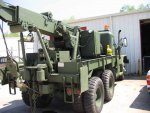I'm pretty sure a wrecker isn't shown - but in my Standard Catalog of US Military Vehicles there is a photo of a M109 with canvas. When considering such things, its important to remember the mindset of the time when they were designed. The foundation of the M-series vehicles was laid even as WWII raged. Many of the specifications for our vehicles were written in the 1940s. The threat at that time was primarily from the air, and the detection system used was the human eye (traveling several hundred miles an hour). A string of canvas-draped trucks all looked alike at speed and from altitude.
Combat troops of that age typically walked where they were going, and even if riding in a truck, would be but a tiny amount of the cargo. An army takes with it thousands of tons of supplies - shoes, food, medical supplies, office supplies, ammo, parts, fuel, water, etc. EVERYTHING that could be used - there was/is no running to the corner market for anything - it all came with the GIs. The vast majority of these goods are not explosive, and not directly used in combat. Anything unusual - a fuel tanker truck, a water tanker, a machine shop, a wrecker - is an expensive vehicle to begin with, and a critical vehicle to the forward movement of the troops - hence a high-value target. So, efforts were made to make it possible for everything to look like "just" a cargo truck from the air.
In today's world, in part due to Hollywood, and in part due to advances in technology (often brought into our living rooms via TV), we expect to be able to tell what kind of sandwich a truck driver in the opposing army is eating - and often can - but it wasn't always that way.
Again, dunno about wreckers, but I've seen photos of tanker and shop van trucks disguised as cargo trucks.
HTH,
David Doyle


